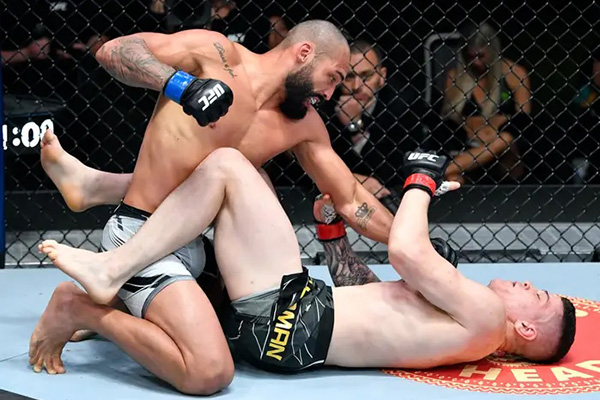20 years ago when Royce Gracie burst upon the scene Jiu-jitsu seemed invincible, inexorable, a force of nature even. Those early UFC fights ushered a revolution in the martial arts community, and put the world on notice: ignore Jiu-jitsu at your peril, because once it hits the ground a BJJ fighter is a shark and you’re in his waters.
But flash forward a few decades and things seem to have changed. Even by the time I began training Jiu-jitsu and competing in mixed martial arts, BJJ competitors were no longer the dominant force in MMA they once were.
Of course the game has evolved, and everyone understands that given the high level of skill of even the average MMA fighter, BJJ isn’t enough to guarantee victory. To get a modern, skilled MMA fighter to the mat takes supreme wrestling as well as striking skills. That is indisputable and natural given the sport’s evolution. Just as strikers had to respect Jiu-jitsu, we now have to respect the stand-up arts.
This is not what concerns me. What concerns me is the failure of BJJ when it is in its element. I have seen Jiu-jitsu fighters lose on the ground, in positions where they should be dominating. I mean how many times have you seen a Jiu-jitsu fighter finally get his opponent to the ground, and then instead of scoring the win, get pounded into a bloody pulp? Way too often. I can give you dozens of examples right off the top of my head. Given the crop of grappling champions in MMA, BJJ should be showcasing its dominant technique on the ground, particularly in the guard. But for some reason it’s not. In fact submissions are at an all time statistical low in the UFC.
Is the guard dead?
One of my first BJJ instructors once said to me that what made the gentle art so unique was, unlike other arts, you could fight effectively off your back. The operational word being fight, not just grapple. But now when it comes to MMA I often hear people say the guard is dead. I can point to countless cases where BJJ champs looked listless, even lost in the guard, eating punch after punch. And often even great grapplers like GSP opt to stand out of guard rather than attack there. One trash talking UFC fighter recently said that he doubted if BJJ was actually even effective anymore. UGH! I can’t tell you how much that pissed me off.
Eddie Bravo has addressed the failure of the guard and lays the blame squarely on the gi. But I don’t think that’s the whole story. The funny thing is criticism of modern BJJ has come from another quarter, Grandmaster Helio himself. Not many people know that some time before passing away he left the IBJJF and refused to sanction its rules…he felt sport Jiu-jitsu was ruining his art. His sons and grandsons stick to a more self-defense style that is quite different from most schools. But I don’t think the answer is to just practice “self defense” either. IBJJF and ADCC sponsored events have in many ways been fantastic laboratories for the development of Jiu-jitsu. They have produced the Marcelo Garcias, the Rafa and Guillerme Mendes’s, the Vieras, all competitors who advanced BJJ by putting their groundbreaking games and techniques on display.
In some ways BJJ is more technical, more evolved than ever. Take any Worlds or ADCC event and you’ll see techniques that no one even thought were possible a decade ago. The gentle art is evolving and improving at a breakneck speed. So why the lack of effectiveness in MMA when it should be even stronger than before?
BJJ for Grappling vs. BJJ for MMA
Here’s my take: Sport Jiu-jitsu, no-gi grappling, and MMA are three different sports with different rules, different environments (the cage), and different ways to score or sway the judges in your favor. It’s only natural that the Jiu-jitsu for each should also differ. The gamesmanship, strategy and approaches are evolving in very, very different ways. BJJ for grappling is no longer the same as BJJ for MMA.
Basically, Jiu-jitsu competitors in both gi and no-gi are competing under a specific set of rules, and they are naturally competing towards those rules in order to win. The same pushing the envelope mentality that has made BJJ more technical than ever, also pushes fighters to play for any little advantage under the rules of sport grappling. But those advantages don’t exist in MMA. In fact, playing to sport rules will not prepare you for MMA. Because, as anyone who has transitioned to MMA knows, punches, elbows and hammerfists make it a very, very different game.
What works in grappling often doesn’t translate to MMA. What’s good for MMA is not always the best in a grappling competition. If anyone knows grappling it’s multiple world champion ADCC champion, and MMA fighter, Robert Drysdale. He comes down squarely on my side of the fence. When teaching MMA fighters he puts it this way: “I have to [change things], to teach to their reality.”
So let’s get to the actual differences in sport guard play versus the MMA guard. For anyone who is training BJJ and wants to transition to MMA, I think you have to recognize two major differences. I want to go over each in separate posts. My next blog post will start with the first and the biggest: sport grappling’s emphasis away from closed guard.
